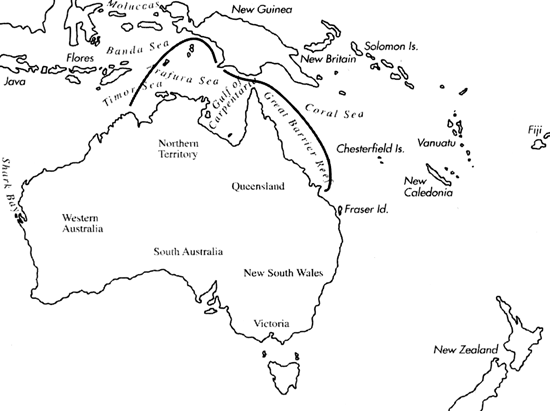Range: Keppel Bay (S. Queensland, Australia) to Arafura Sea (Aru, Indonesia) and Timor Sea (Joseph Bonaparte Gulf, N. W. Australia).
Description: Moderately small to medium-sized, moderately solid. Last whorl conical to ventricosely conical or conoid-cylindrical, outline slightly convex at adapical third and straight below. Shoulder usually sharply angulate. Spire of low to moderate height, outline concave. Larval shell of about 2 whorls, maximum diameter 0.8-0.9 mm. First 0.75-3 postnuclear whorls weakly tuberculate; specimens of about 45 mm with about 10 postnuclear whorls. Teleoconch sutural ramps flat, sometimes concave in late whorls, with 1 increasing to 4-6 spiral grooves. Last whorl with variably broad spiral ribbons extending from base to shoulder, sometimes replaced by ribs near base and just below shoulder; intervening grooves axially striate, wider at base and often containing a fine spiral rib; large specimens almost smooth on adapical third to half.
| Shell Morphometry | ||
|---|---|---|
| L | 30-55 mm | |
| RW | 0.10-0.22 g/mm | |
| RD | 0.52-0.63 | |
| PMD | 0.83-0.91 | |
| RSH | 0.08-0.15 | |
Ground colour white. Last whorl with rather sparse spiral rows of widely separated brown spots, concentrated and fusing into larger axial markings below shoulder and within adapical as well as basal third. Brown spots often irregularly scattered. Larval whorls white. Postnuclear sutural ramps sparsely maculated with brown spots or radial streaks. Aperture white.
Habitat and Habits: In 25-60 m.
Discussion: C. lizardensis resembles C. minnamurra, C. colmani, and C. limpusi. C. minnamurra can be distinguished from C. lizardensis by its broader last whorl (RD 0.64-0.72), non tuberculate postnuclear whorls, straight to convex spire outline and usually smaller size (to 36 mm). C. colmani has a broader last whorl (RD 0.62-0.73), an angulate rather than sharply angulate shoulder, and strong tubercles on its first 3-6 postnuclear whorls. In similarly sized specimens, C. colmani is heavier but has fewer postnuclear whorls (8.5) than C. lizardensis. C. limpusi differs in its more solid shell (L 55 mm: RW 0.30-0.40 g/mm), generally more convex-sided last whorl, angulate rather than sharply angulate shoulder, and in its strongly tuberculate 2-7 early postnuclear whorls. C. minnamurra, C. colmani, and C. limpusi have a broader larval shell (maximum diameter in C. minnamurra 1.1 mm; in C. colmani 1.05- 1.15 mm; in C. limpusi 1.2-1.3 mm). This species is often referred to as C. sibogae (see Walls, [1979]). Cernohorsky (1978) and Coomans & Filmer (1985) considered C. sibogae a junior synonym of C. lizardensis. Röckel & Korn (1990) agreed with this conclusion, in particular as the same larval shell diameter (0.8-0.9 mm) suggests conspecific status for the (subadult) type specimens of C. lizardensis Crosse and C. mucronatus var. sibogae Schepman. Bathymetric and zoogeographical data support this taxonomic hypothesis: The type localities of C. lizardensis and C. sibogae as well as the depth in which the latter holotype was collected (57 m) do not correspond with the geographical and bathymetrical ranges of C. limpusi, C. minnamurra or C. colmani.

C. lizardensis range map
This section contains verbatim reproductions of the accounts of 316 species of Conus from the Indo-Pacific region, from Manual of the Living Conidae, by Röckel, Korn and Kohn (1995). They are reproduced with the kind permission of the present publisher, Conchbooks.
All plates and figures referred to in the text are also in Röckel, Korn & Kohn, 1995. Manual of the Living Conidae Vol. 1: Indo-Pacific Region.
The range maps have been modified so that each species account has it own map, rather than one map that showed the ranges of several species in the original work. This was necessary because each species account is on a separate page on the website and not confined to the order of accounts in the book.